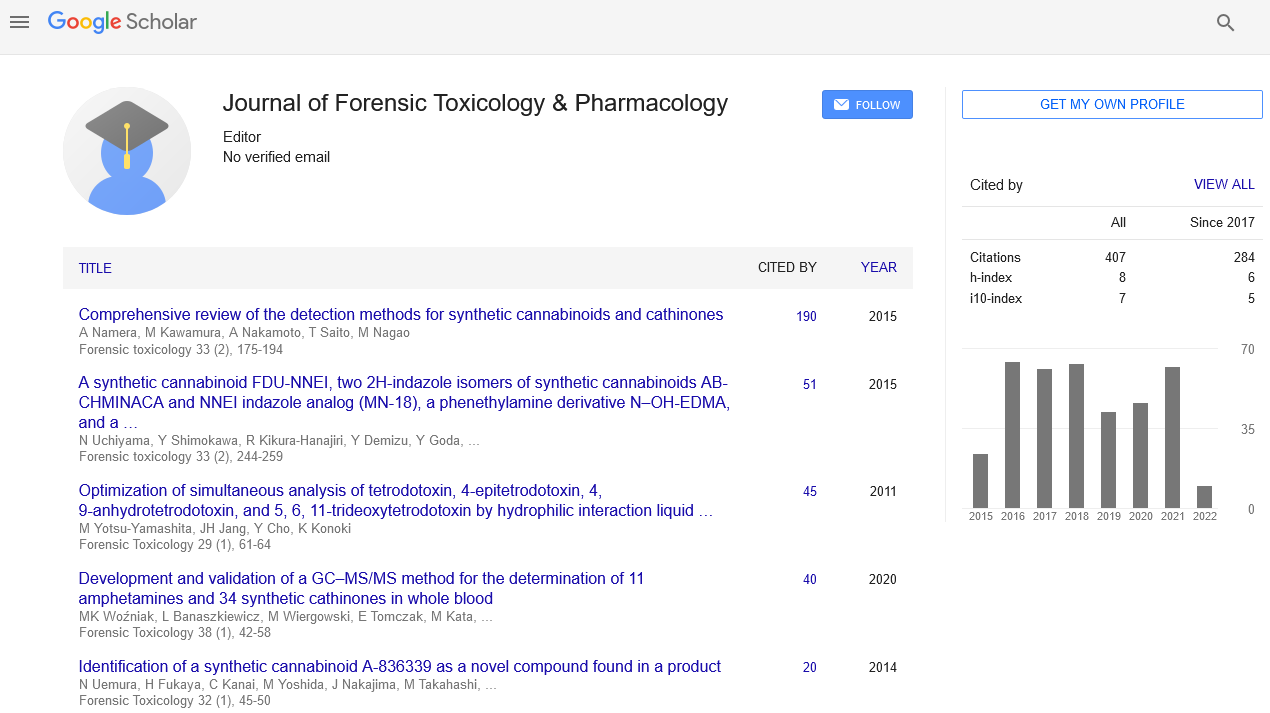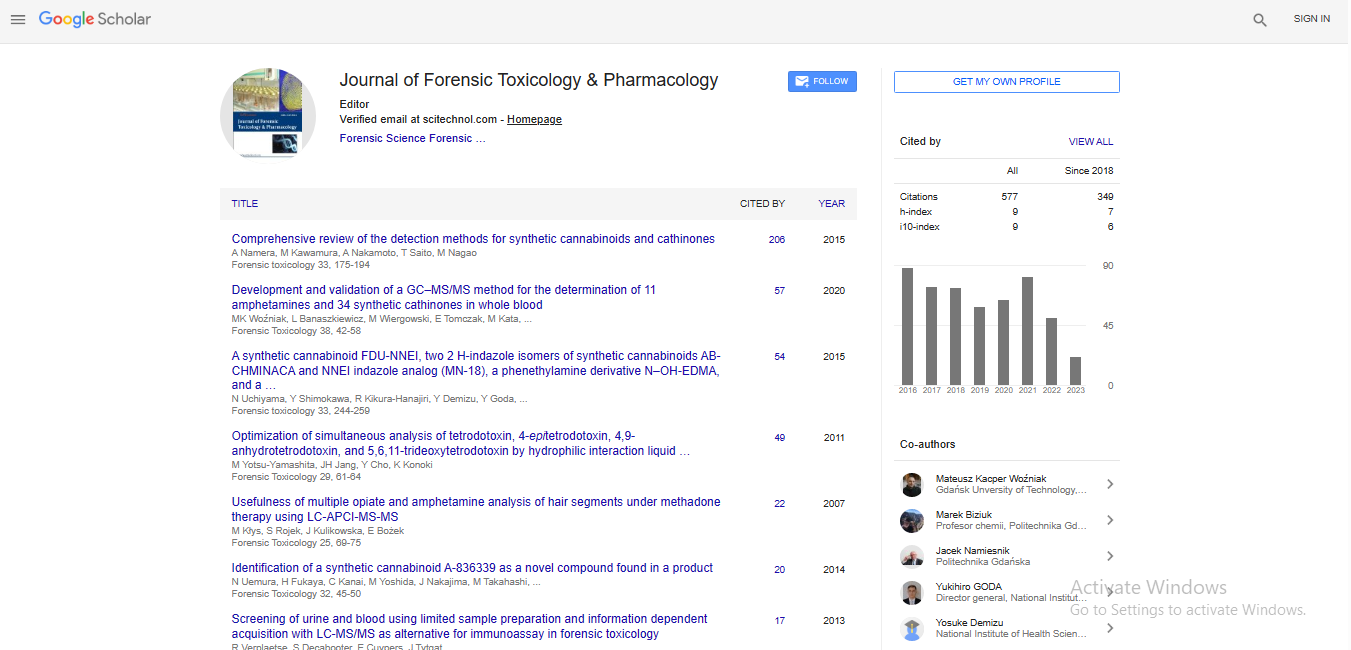Commentary, J Forensic Toxicol Pharmacol Vol: 13 Issue: 3
Nanotoxicology in Medicine: Evaluating the Impact of Nanoparticles on Human Health and Drug Efficacy
Aiko Yamamoto*
1Department of Toxicology, University of Tokyo, Tokyo, Japan
*Corresponding Author: Aiko Yamamoto,
Department of Toxicology, University of
Tokyo, Tokyo, Japan
E-mail: yamamotoaiko@gmail.com
Received date: 26 August, 2024, Manuscript No. JFTP-24-151889;
Editor assigned date: 28 August, 2024, PreQC No. JFTP-24-151889 (PQ);
Reviewed date: 11 September, 2024, QC No JFTP-24-151889;
Revised date: 18 September, 2024, Manuscript No. JFTP-24-151889 (R);
Published date: 25 September, 2024, DOI: 10.4172/JFTP.1000200
Citation: Yamamoto A (2024) Nanotoxicology in Medicine: Evaluating the Impact of Nanoparticles on Human Health and Drug Efficacy. J Forensic Toxicol Pharmacol 13:3.
Description
Nanoparticles are increasingly used in medicine to improve drug delivery, diagnostic techniques and therapeutic interventions. Due to their minute size and unique properties, nanoparticles offer a range of possibilities for enhancing the way treatments are delivered and administered. However, the incorporation of nanoparticles into medical applications raises essential questions about safety and potential toxicity. This area of research, known as nanotoxicology, examines the effects of nanoparticles on human health and the effectiveness of drugs, helping to balance the benefits of these technologies with their risks.
Nanoparticles are materials on the scale of one-billionth of a meter, often composed of metals, polymers, or other organic compounds. Their small size and surface properties allow them to interact with biological molecules in unique ways. In medicine, nanoparticles are employed to transport drugs directly to specific cells or tissues. This targeted approach minimizes the side effects of treatments and enhances drug concentration at the desired site. Cancer treatments and diagnostic imaging are notable fields where nanoparticle technology has shown potential, with nanoparticles used to deliver chemotherapy drugs to tumors or to improve the accuracy of imaging. Yet, as nanoparticles interact with the body on a cellular level, their behavior differs significantly from that of larger particles. This can affect various bodily systems, leading to questions about how nanoparticles might influence health and drug efficacy over time.
One of the primary concerns in nanotoxicology is that nanoparticles may enter cells and tissues they would not normally access, leading to unexpected effects. Their small size enables them to penetrate cell membranes, potentially disrupting cellular functions or even reaching sensitive areas, such as the brain. Once inside, nanoparticles can react with biological components differently from larger materials, which can alter immune responses or create oxidative stress that damages cells.
Another concern involves the way nanoparticles may interact with drugs, altering their effects or triggering unexpected side effects. Research suggests that some nanoparticles can bind to drug molecules, modifying how they are distributed, absorbed, or metabolized in the body. Understanding these interactions is essential to developing safe nanoparticle-based drug formulations.
The body may not easily eliminate certain types of nanoparticles, causing them to accumulate over time. This raises questions about the potential for chronic exposure and long-term health effects, especially when nanoparticles are used in treatments requiring repeated doses. For example, metal-based nanoparticles may gradually build up in organs, possibly leading to toxic effects over extended periods. Animal studies have shown that high levels of certain nanoparticles can lead to inflammation, liver damage, or respiratory issues. While these findings do not always translate directly to humans, they highlight the need for careful investigation into how different nanoparticles might affect the body over a lifetime.
Developing safe nanoparticles requires detailed studies to understand how each type of particle behaves in the body. Researchers focus on factors like size, shape and surface chemistry to predict how nanoparticles will interact with cells and tissues. By controlling these characteristics, scientists aim to design nanoparticles that perform their intended functions without causing unintended harm. Additionally, current studies aim to identify nanoparticle thresholds that remain safe for human exposure, accounting for factors like dosage, duration and individual variability. Safety protocols and regulations are essential to ensure that nanoparticle-based treatments undergo rigorous testing before entering clinical settings.
Nanoparticles hold promise for advancing medical treatments through targeted drug delivery and innovative diagnostic methods. However, the very properties that make nanoparticles useful also present challenges for ensuring their safe use. Nanotoxicology plays an essential role in this field, examining how nanoparticles affect human health and drug efficacy, aiming to establish a balance between the benefits and risks. By understanding the interactions between nanoparticles and biological systems, researchers can develop medical applications that integrate the advantages of these materials while minimizing their potential health impacts.
 Spanish
Spanish  Chinese
Chinese  Russian
Russian  German
German  French
French  Japanese
Japanese  Portuguese
Portuguese  Hindi
Hindi 
